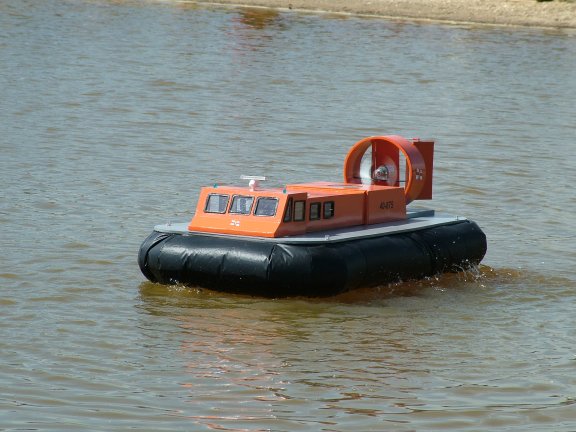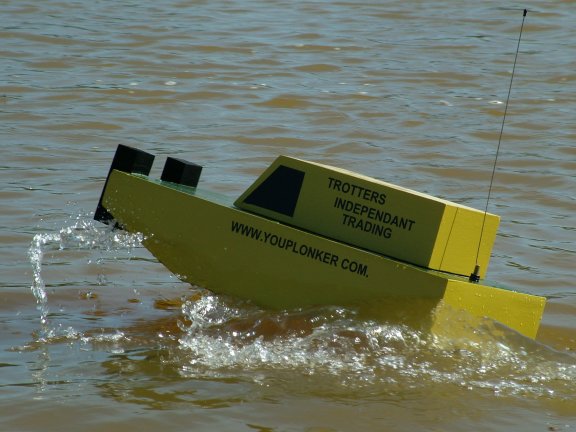
|
|
|
|
Griffin Hovercraft(Reprint of an article from the June 2008, Summer SRCMBC Newsletter; there is a new vdeo of this Hovercraft here)The hovercraft that I was building and I wrote about in the Spring Newsletter is now complete. Weighing in at 8lbs 7.25 ounces it was flight tested at Setley recently and worked better than I expected, lifting well. Having said that, I had to replace the propeller with one with a thicker chord. Forward speed was a little slower than expected but a motor change rectified that. Reverse will always be slow, mainly because of the propeller pitch and the position within the duct, but it served its purpose and was at an acceptable level. The twin rudders were more effective than I expected. I was anticipating having to add a 3rd rudder which fortunately I will not now have to do. During the flight I set her down on the pond to test if water would leak into the skirt or the electronics bay. The result was fantastic, no water entered the craft, thankfully. 
Running time was also much better than expected. I knew that both motors could run continuously for 9 minutes but would start to show the battery was getting low after 8.5 minutes. I intended to bring her in after 8 minutes but Alan Bond was doing a video of her for me (view video). In the excitement I forgot to set my timer, so thinking she must have run for 6 minutes I brought her in to do some checks. She died as soon as she hit land! It was only then that Alan told me that he had nearly 10 minutes of video. Later in the day I had 2 more successful flights although there was a problem with what I thought was radio interference. However, it turned out that removing the gyro I'd fitted rectified that. On the second session at the pond a couple of weeks later, things were not so good. After the first flight the craft got sluggish and she was producing a bow wave, indicating that she was not going over the hump, that is starting to ride on the air cushion. This turned out to be due to too much pressure in the skirt which forced the back corners to part company with thebottom of the hull. This led to several hours work taking the skirt off and re-fitting it. I also removed the baffle plate at the bottom of the hull so as to get more air in the plenum and lessin the skirt bag. Strangely enough after doing that, no water entered the skirt or soaked intothe hull frame as the air pressure was so great. 
Another thing I tested was the recovery boat I built just to recover the hovercraft should it stop midpond. This is the fun boat which looks like Del Boys van, it has become known by several members as Plonker (view video). I stopped the hovercraft out in the pond as if it had broken down. I then sent Plonker out to recover it by pushing it ashore using the large buffers on the front. The system worked perfectly. I am now thinking of adding a large magnet to the back of the Plonker and also putting a metal strip inside the skirt bag at the front. This way I should have the option to be able to tow the hovercraft back. I have been asked what I am going to do next. Firstly I am going to rebuild the rear part ofthe Griffin cabin as I would like a larger air intake as well as two side intakes. After that I may well build a model of a US Army hovercraft. I was also thinking of building another Griffin using different materials and possibly having twin pusher motors. Pete Bryant |
